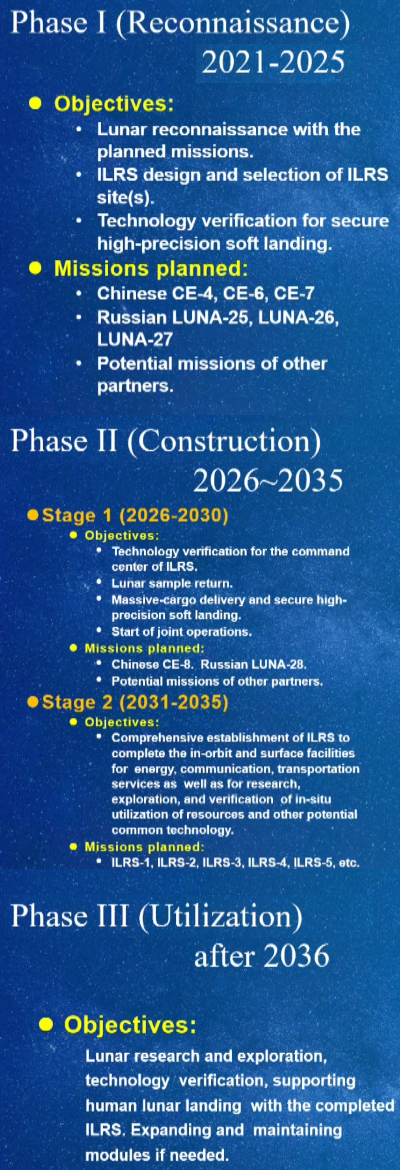China successfully tests a three-satellite constellation in lunar space

The original Chinese-Russian lunar base plan, from June 2021.
Most of the Russian components are not expected to launch.
China’s state-run press today announced that it has successfully completed the first three-satellite communications test of a constellation in a Distant Retrograde Orbit (DRO) in lunar space.
DRO-A and DRO-B, two satellites developed by the Chinese Academy of Sciences (CAS) and deployed in the DRO, have established inter-satellite measurement and communication links with DRO-L, a previously launched near-Earth orbit satellite. The achievement was disclosed at a symposium on Earth-moon space DRO exploration in Beijing on Tuesday.
DRO is a unique type of orbit, and the Earth-moon space refers to the region extending outward from near-Earth and near-lunar orbits, reaching a distance of up to 2 million kilometers from Earth. In the Earth-moon space, DRO is characterized by a prograde motion around Earth and a retrograde motion around the moon, said Wang Wenbin, a researcher at the CAS’ Technology and Engineering Center for Space Utilization (CSU). Since DRO provides a highly stable orbit where spacecraft require little fuel to enter and stay, it serves as natural space hub connecting Earth, the moon and deep space, offering support for space science exploration, the deployment of space infrastructure, and crewed deep-space missions, Wang said.
On Feb. 3, 2024, the experimental DRO-L satellite was sent into a sun-synchronous orbit and began conducting experiments as planned. The DRO-A/B dual-satellite combination was launched from the Xichang Satellite Launch Center in southwest China’s Sichuan Province on March 13, 2024, but failed to enter its intended orbit due to an anomaly in the upper stage of the carrier rocket.
Facing this challenge, the satellite team performed a “life-or-death” rescue operation under extreme conditions, promptly executing multiple emergency orbit maneuvers to correct the trajectory of the two satellites. After a journey of 8.5 million kilometers, the DRO-A/B dual-satellite combination ultimately reached its designated orbit, according to Zhang Hao, a researcher at CSU who participated in the rescue operation.
On Aug. 28, 2024, the two satellites were successfully separated. Later, both DRO-A and DRO-B established K-band microwave inter-satellite measurement and communication links with DRO-L, testing the networking mode of the three-satellite constellation, Zhang said.
China’s government space program continues to follow a very rational and well-thought-out plan for establishing a manned base on the Moon, as shown in the 2021 graph to the right that China appears to be achieving as planned. While it is very likely it will not meet its 2030 goal for landing a human on the Moon, it is clearly establishing the technology for making that landing in a reasonable timeline with a later long-term permanent presence in a lunar base possible.

The original Chinese-Russian lunar base plan, from June 2021.
Most of the Russian components are not expected to launch.
China’s state-run press today announced that it has successfully completed the first three-satellite communications test of a constellation in a Distant Retrograde Orbit (DRO) in lunar space.
DRO-A and DRO-B, two satellites developed by the Chinese Academy of Sciences (CAS) and deployed in the DRO, have established inter-satellite measurement and communication links with DRO-L, a previously launched near-Earth orbit satellite. The achievement was disclosed at a symposium on Earth-moon space DRO exploration in Beijing on Tuesday.
DRO is a unique type of orbit, and the Earth-moon space refers to the region extending outward from near-Earth and near-lunar orbits, reaching a distance of up to 2 million kilometers from Earth. In the Earth-moon space, DRO is characterized by a prograde motion around Earth and a retrograde motion around the moon, said Wang Wenbin, a researcher at the CAS’ Technology and Engineering Center for Space Utilization (CSU). Since DRO provides a highly stable orbit where spacecraft require little fuel to enter and stay, it serves as natural space hub connecting Earth, the moon and deep space, offering support for space science exploration, the deployment of space infrastructure, and crewed deep-space missions, Wang said.
On Feb. 3, 2024, the experimental DRO-L satellite was sent into a sun-synchronous orbit and began conducting experiments as planned. The DRO-A/B dual-satellite combination was launched from the Xichang Satellite Launch Center in southwest China’s Sichuan Province on March 13, 2024, but failed to enter its intended orbit due to an anomaly in the upper stage of the carrier rocket.
Facing this challenge, the satellite team performed a “life-or-death” rescue operation under extreme conditions, promptly executing multiple emergency orbit maneuvers to correct the trajectory of the two satellites. After a journey of 8.5 million kilometers, the DRO-A/B dual-satellite combination ultimately reached its designated orbit, according to Zhang Hao, a researcher at CSU who participated in the rescue operation.
On Aug. 28, 2024, the two satellites were successfully separated. Later, both DRO-A and DRO-B established K-band microwave inter-satellite measurement and communication links with DRO-L, testing the networking mode of the three-satellite constellation, Zhang said.
China’s government space program continues to follow a very rational and well-thought-out plan for establishing a manned base on the Moon, as shown in the 2021 graph to the right that China appears to be achieving as planned. While it is very likely it will not meet its 2030 goal for landing a human on the Moon, it is clearly establishing the technology for making that landing in a reasonable timeline with a later long-term permanent presence in a lunar base possible.
